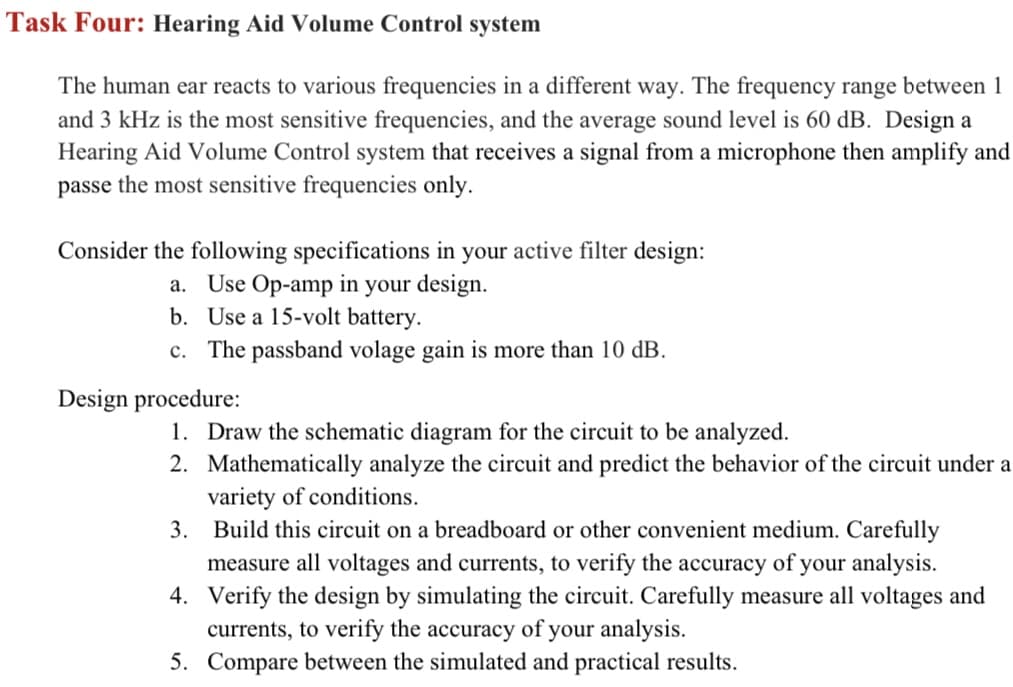Task Four: Hearing Aid Volume Control system The human ear reacts to various frequencies in a different way. The frequency range between 1 and 3 kHz is the most sensitive frequencies, and the average sound level is 60 dB. Design a Hearing Aid Volume Control system that receives a signal from a microphone then amplify and passe the most sensitive frequencies only. Consider the following specifications in your active filter design: a. Use Op-amp in your design. b. Use a 15-volt battery. c. The passband volage gain is more than 10 dB. Design procedure: 1. Draw the schematic diagram for the circuit to be analyzed. 2. Mathematically analyze the circuit and predict the behavior of the circuit under a variety of conditions. 3. Build this circuit on a breadboard or other convenient medium. Carefully measure all voltages and currents, to verify the accuracy of your analysis. 4. Verify the design by simulating the circuit. Carefully measure all voltages and currents, to verify the accuracy of your analysis. 5. Compare between the simulated and practical results.
Task Four: Hearing Aid Volume Control system The human ear reacts to various frequencies in a different way. The frequency range between 1 and 3 kHz is the most sensitive frequencies, and the average sound level is 60 dB. Design a Hearing Aid Volume Control system that receives a signal from a microphone then amplify and passe the most sensitive frequencies only. Consider the following specifications in your active filter design: a. Use Op-amp in your design. b. Use a 15-volt battery. c. The passband volage gain is more than 10 dB. Design procedure: 1. Draw the schematic diagram for the circuit to be analyzed. 2. Mathematically analyze the circuit and predict the behavior of the circuit under a variety of conditions. 3. Build this circuit on a breadboard or other convenient medium. Carefully measure all voltages and currents, to verify the accuracy of your analysis. 4. Verify the design by simulating the circuit. Carefully measure all voltages and currents, to verify the accuracy of your analysis. 5. Compare between the simulated and practical results.
Introductory Circuit Analysis (13th Edition)
13th Edition
ISBN:9780133923605
Author:Robert L. Boylestad
Publisher:Robert L. Boylestad
Chapter1: Introduction
Section: Chapter Questions
Problem 1P: Visit your local library (at school or home) and describe the extent to which it provides literature...
Related questions
Question

Transcribed Image Text:Task Four: Hearing Aid Volume Control system
The human ear reacts to various frequencies in a different way. The frequency range between 1
and 3 kHz is the most sensitive frequencies, and the average sound level is 60 dB. Design a
Hearing Aid Volume Control system that receives a signal from a microphone then amplify and
passe the most sensitive frequencies only.
Consider the following specifications in your active filter design:
a. Use Op-amp in your design.
b. Use a 15-volt battery.
c. The passband volage gain is more than 10 dB.
Design procedure:
1. Draw the schematic diagram for the circuit to be analyzed.
2. Mathematically analyze the circuit and predict the behavior of the circuit under a
variety of conditions.
3.
Build this circuit on a breadboard or other convenient medium. Carefully
measure all voltages and currents, to verify the accuracy of your analysis.
4. Verify the design by simulating the circuit. Carefully measure all voltages and
currents, to verify the accuracy of your analysis.
5. Compare between the simulated and practical results.
Expert Solution
This question has been solved!
Explore an expertly crafted, step-by-step solution for a thorough understanding of key concepts.
Step by step
Solved in 3 steps with 3 images

Knowledge Booster
Learn more about
Need a deep-dive on the concept behind this application? Look no further. Learn more about this topic, electrical-engineering and related others by exploring similar questions and additional content below.Recommended textbooks for you

Introductory Circuit Analysis (13th Edition)
Electrical Engineering
ISBN:
9780133923605
Author:
Robert L. Boylestad
Publisher:
PEARSON

Delmar's Standard Textbook Of Electricity
Electrical Engineering
ISBN:
9781337900348
Author:
Stephen L. Herman
Publisher:
Cengage Learning

Programmable Logic Controllers
Electrical Engineering
ISBN:
9780073373843
Author:
Frank D. Petruzella
Publisher:
McGraw-Hill Education

Introductory Circuit Analysis (13th Edition)
Electrical Engineering
ISBN:
9780133923605
Author:
Robert L. Boylestad
Publisher:
PEARSON

Delmar's Standard Textbook Of Electricity
Electrical Engineering
ISBN:
9781337900348
Author:
Stephen L. Herman
Publisher:
Cengage Learning

Programmable Logic Controllers
Electrical Engineering
ISBN:
9780073373843
Author:
Frank D. Petruzella
Publisher:
McGraw-Hill Education

Fundamentals of Electric Circuits
Electrical Engineering
ISBN:
9780078028229
Author:
Charles K Alexander, Matthew Sadiku
Publisher:
McGraw-Hill Education

Electric Circuits. (11th Edition)
Electrical Engineering
ISBN:
9780134746968
Author:
James W. Nilsson, Susan Riedel
Publisher:
PEARSON

Engineering Electromagnetics
Electrical Engineering
ISBN:
9780078028151
Author:
Hayt, William H. (william Hart), Jr, BUCK, John A.
Publisher:
Mcgraw-hill Education,